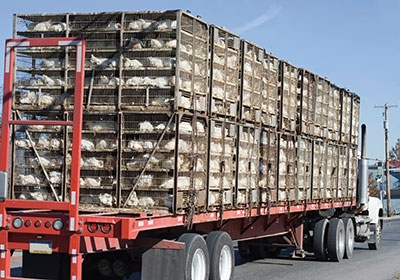
Understanding Broiler Transport Mortalities
By Kim Waalderbos
Features Broilers Equipment Health Poultry Equipment Business/Policy CanadaMany causes can affect transport losses
 In total, 5,184 loads of broilers between January 2009 and August 2010 were studied by PhD candidate Niamh Caffrey from the University of Prince Edward Island.
In total, 5,184 loads of broilers between January 2009 and August 2010 were studied by PhD candidate Niamh Caffrey from the University of Prince Edward Island. There are multiple risk factors that can affect the mortality rates in loads of broilers transported to slaughter. That’s the word from PhD candidate Niamh Caffrey, who presented her research findings at the Sir James Dunn Animal Welfare Centre Poultry Welfare conference in Charlottetown, P.E.I., earlier in the year.
Caffrey, in collaboration with Drs. Michael Cockram and Ian Dohoo at the University of Prince Edward Island, studied the risk factors affecting mortality rates in loads of broilers transported for slaughter.
With support from the Animal Welfare Foundation of Canada and the Sir James Dunn Animal Welfare Centre at the University of Prince Edward Island, she found that a number of key factors could significantly influence mortality rates.
“When transporting broilers, the duration of various stages during transport and environmental conditionals can have a major effect on mortality rates,” she said.
For the study, the researchers analyzed slaughter-plant records on loads of broilers travelling from barns in the Atlantic Provinces and Quebec to a major slaughter plant in the Maritimes.
At each stage of the journey, different sets of data were collected, including flock characteristics, loading information, time periods for each stage of the journey, external temperatures, weather conditions, trailer temperatures and ventilation.
In total, records on 5,184 loads of broilers between January 2009 and August 2010 were in the study.
Broilers ranged in age from 33 to 45 days (average 38 days of age) and 1.6 to 2.9 kilograms in weight. The median mortality rate (per cent of those dead on arrival) for all loads was calculated to be 0.29 per cent.
Of the total loads tracked, 90 loads had mortality rates of zero per cent, and 168 loads reported mortality rates greater than two per cent.
Using a statistical program, Caffrey was able to determine what constituted an “average journey” for a load of broilers, and presented models to predict how changes in each factor affected the mortality rate of an average journey.
She said mortality rates increased significantly when both duration times and environmental conditions were different from the “average journey.”
“As the duration of time spent loading, or in transit, or in the holding barn, increased, then mortality rates also increased,” said Caffrey. Couple this with humidity changes such as wet, snowy weather, she said, and it’s a recipe for increased mortality.
As an example of the effect of colder temperatures, Caffrey said that when the external temperature was 0 C there was 0.37 per cent mortality, at -15 C there was 0.69 per cent, and at -35 C there was 2.19 per cent of birds dead on arrival.
Caffrey said it could be challenging to control a number of these factors due to the design of trucks, as ventilation methods are typically achieved through manual adjustments of panels and tarpaulins.
She added that paying careful attention to ventilation and adjusting stocking density as required can help to make broilers more comfortable in their journey and reduce the risk of mortality.
As well, during transport in extreme cold conditions, she said that management of ventilation and stocking density is crucial – too much ventilation can cause the birds to become cold, but when the ventilation is closed, heat and humidity can build up in the trailer and the birds can become too hot.
“There’s a wide potential of external temperatures that birds can be exposed to during transport,” she said, adding that as the journey progresses, loads already in “danger” are particularly sensitive to waiting times and environments.
Caffrey also added that there was not a statistical significant difference in mortality rates based on the barn of origin, producer or truck driver.
“There was a bigger influence of individual loads versus those from certain barns or producers,” she said.
Print this page